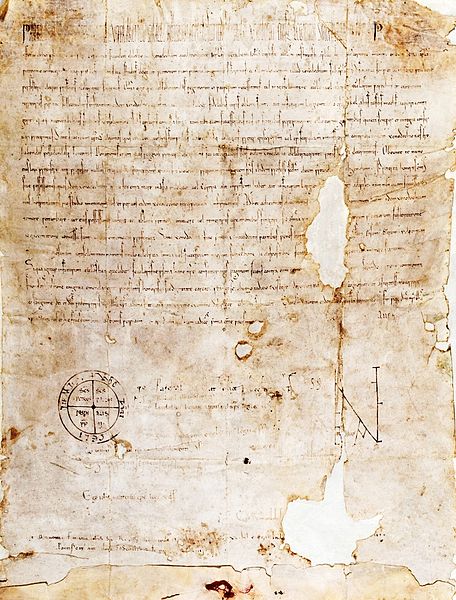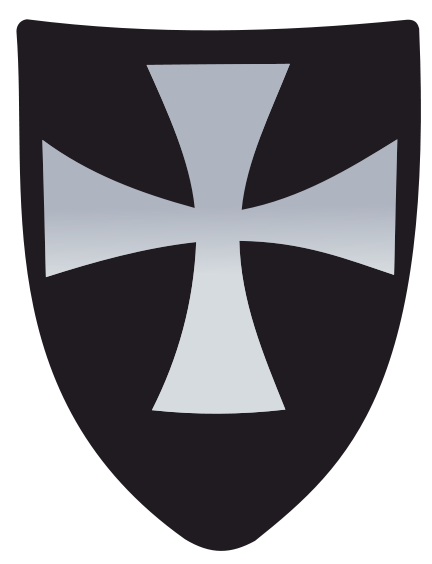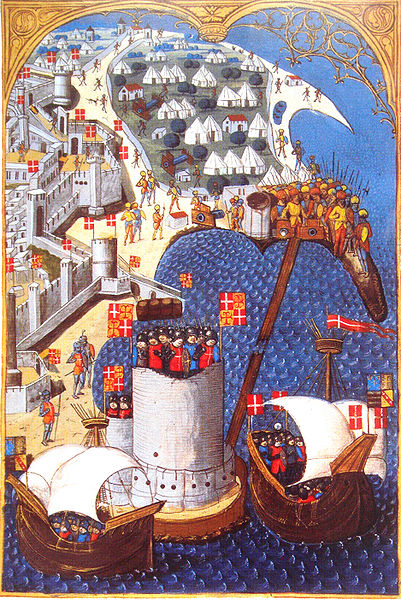by Raymond Drake
Nine hundred years ago, on February 15, 1113, Pope Paschal II issued the bull Pie Postulatio Voluntatis approving a hospitaller religious order that today is Christendom’s oldest order of chivalry: The Sovereign Military Hospitaller Order of St. John of Jerusalem of Rhodes and of Malta. The Pope made the order independent from all temporal power and dependent directly on the Holy See.
Papal bull Pie Postulatio Voluntatis confirming the foundation of the Knights of Malta
It all began a year or so after the 1099 conquest of Jerusalem by Godfrey of Bouillon and the First Crusade, when Blessed Gerard Tum (aka Thom, Tenque) was made provost of the Men’s Hospice in Jerusalem. Little is known of his ancestry and early years. Some say he hailed from Amalfi, Italy, while others claim him for Provence, in France. In Jerusalem, Brother Gerard recruited the Order’s first members, and later secured papal approval for it.
In 1118, Blessed Gerard was succeeded in the Order’s government by Raymond du Puy de Provence. It was under du Puy that the Order, which had been dedicated at its founding to the nursing of the sick, added its military wing to provide armed escort to pilgrims coming to and returning from the Holy Places. The ever-present Muslim menace against the Crusaders’ small kingdom in the Holy Land would turn the Order into a formidable fighting force. It was also Raymond du Puy who chose the white eight-pointed cross atop a black surcoat as the Order’s symbol.
Raymond du Puy de Provence
By mid-twelfth century, the Knights Hospitaller, as they were called, had spread considerably not just in the Middle East but in Europe. Several castles and strongholds had been entrusted to their keep, and perhaps the most noted was the Krak des Chevaliers, a massive fortress near present-day Homs, in Syria. Considered to be impregnable, it had a 2,000-man garrison at its peak, in the thirteenth century.
The last years of the thirteenth century brought with them the defeat and collapse of the Crusader Kingdom of Jerusalem. The Knights Hospitaller lost all their holdings on the mainland of Asia Minor, and had to settle briefly in Cyprus. In 1309, they moved to the island of Rhodes, which would be theirs for 200 years. It was in Rhodes that the Knights developed a navy, using it to raid, sink, and capture Muslim shipping in the Mediterranean.
Bl. Gerard Thom
A new period of distress came to the Order in 1522, when they lost Rhodes, after months of siege, to the Ottoman Sultan, Suleiman the Magnificent.
Knights Hospitaller shield
Some years later, Charles V, Holy Roman Emperor, gave them the archipelago of Malta and the territory of Tunis as a new base of operations. It was on the small island of Malta (95 sq. miles), under the Order’s forty-ninth Grand Master, Jean Parisot de la Valette, that the Knights became instrumental in saving Christian Europe from the threat of Islam. During the spring and summer of 1565, they endured what is known as the Great Siege of Malta. Once again, it was Sultan Suleiman who desired their ruin. The Sultan sent a powerful fleet and 48,000 of his best troops under the command of his best general, Mustapha Pasha, to destroy the Knights. After four months of fierce fighting, the Turkish army retreated to their galleys and set sail for the Golden Horn. A conquest of Malta would have given the Sultan unrivaled control over the Mediterranean and given him a bridgehead to conquer Sicily and the Italian mainland, especially Rome, the city of the Popes.
Six years later, in 1571, the Knights distinguished themselves anew in the Battle of Lepanto where their ships were part of the fleet of the Holy League. This greatest of naval battles crushed Turkish aspirations to maritime supremacy forever.
Krak des Chevaliers in Syria, a Knights Hospitaller fortress that helped defend the border of the Kingdom of Jerusalem.
The Knights were not spared the devastation and ruin visited upon Christendom by the French Revolution. In 1798, Napoleon Bonaparte conquered Malta and the Knights were left without a territory of their own. All of Europe was in convulsion and it was not until 1834 that the Knights were able to establish a permanent headquarters in Rome.
From then until our days, the Grand Master has presided over the Order’s activities around the world from the Magistral Palace on the Via dei Condotti 68 and the Magistral Villa on the Aventine Hill, both of which enjoy extraterritorial status. The Order’s activities are limited today to its ancient charitable and hospitaller functions, for since the loss of Malta there are no conditions to revive its military one.
Siege of Rhodes. In 1480, with an army of 500 knights and 2,000 soldiers the Knights Hospitaller withstood an army of 70,000 Turks of the Ottoman Empire.
For a long time, the Order was structured in varying categories of knights, but the highest of these was comprised by the Knights of Justice. These were considered to be the successors of the monk-warriors who had formed the heart of the Order in its best days. Knights of Justice are professed religious, and make the three solemn monastic vows of poverty, chastity, and obedience. It is from among their ranks that the Grand Master and other officials governing the Order are elected.
For centuries, Knights of Justice had to prove nobiliary birth not just for themselves, but for all ancestors going back to their great-grandparents. Today, in a sad surrender to the revolutionary egalitarianism of the age, the Order has begun to admit members who do not meet these standards.
However, the venerable, aristocratic tone distilled over 900 years of noble membership, and the glorious aura of a Crusader past, have garnered for the Order the respect and admiration of many who pray for a day when it will shine again in full splendor.







No comments:
Post a Comment